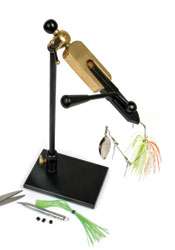
Everyone loves the spinnerbait.It’s the most versatile bait of all,” angling legend Bill Dance told his television audience recently. “It’s the lure a fisherman should master, for sure, because it can be fished at so many different depths and so many conditions … all 12 months of the year.”I switched channels and heard much the same.”It’s the most popular lure type out there,” echoed Rick Clunn, voted No. 1 in Bassmaster’s Greatest Angler Debate.And it’s a bait that loves right back — a veritable Will Rogers of the ol’ tacklebox that never knew a bass fisherman it didn’t like … or, at least, couldn’t charm.Its beauty lies in its perceived simplicity. Cast it. Retrieve it. Watch it flash.And, on a good day, it seems you cannot fish it wrong.
But this brightest of baits has its dark side, too. A spinnerbait can frustrate an angler with its tendency to produce short hits or to simply go ice cold. If you want to maximize your success and minimize your frustration, take the spinnerbait off your “no-brainer bait” list and recognize it as a sophisticated piece of hardware, a three-way hybrid of blade, fly and jig that you must fine-tune for optimum performance.
BLADE NIPPERS
The bass on Lake Guntersville are aggressive, says Tim Chandler, a prominent guide on the Alabama impoundment renowned for its spinnerbait bite. He thinks Guntersville’s vast acreage of hydrilla and milfoil and a belt-busting forage base of shad and bluegill make the lake’s bass aggressive.Bass positioned in the grass are looking up, Chandler explains. “They’re just waiting for something to come by so they can ambush it.” A flashing spinnerbait brings out their aggression.Yet short hits are common even among Guntersville’s gluttonous bass stock. What gives?
“When bass hit short on a spinnerbait, they are often hitting the blade and not the hook,” says Chandler, who often prefers a Booyah Double Willow Blade with paired gold and nickel-plated blades or a Tandem (willow with small Colorado) combination.Chandler adjusts his bait to the short strikes. “My first thought is to bend the spinnerbait down to get the hook closer to the blade,” he says. “Sometimes I add a trailer hook so I have two hooks close to the blade. If they are hitting the blade, it may be a sign that I need to change the skirt, as well — either make it more attractive or change it altogether.”
SKIRT SCIENCE
The skirt talk led me to Guido Hibdon, an inveterate tinkerer. Guido and son Dion have turned skirt selection on spinnerbaits and jigs into both art and science.
Bass generally hit a spinnerbait because they perceive it as a baitfish or something moving past them really fast. Though a spinnerbait may draw a reaction strike, the degree to which the bait resembles the real deal may determine the fish’s degree of commitment — whether the bass inhales the bait or just nips at the filaments of plastic.
“The blade is an attractant,” explains Hibdon. “But you need the right colors to get the bass to eat it. … It usually comes back to the skirt.”
The Hibdons designed a series of skirt-making kits for Skirts Plus of Savage, Minn., called Hibdon’s Classic Kits, with complete materials and tools for making jig and spinnerbait skirts.Skirt selection is a process based on water color and preferred forage. Hibdon generally selects dark natural colors in dark water; brighter colors (with whites and flash) in clear water; firetiger in stained water and most Florida waters; and “pearl white and pink for any place up north that has smallmouth.”
When he suspects bass are feeding on a select forage species, Hibdon attempts to match the hatch, mixing skirt materials to get a combination that will mimic the baitfish’s appearance.You can match anything,” he says. “For a golden shiner, it’s gold on the side with pearl white. Match a blueback herring with a dark olive back and a couple of strips of pearl white down the side and two tiny strips of red for the belly.”
BLADE MAGIC
A spinnerbait appeals powerfully not only to a bass’ sense of sight but to the sensations of sound and vibration, too. Blade types and blade positioning help tap into a bass’ rhythm.Aim at optimizing the mix of flash and water displacement that conditions demand.Bright, clear water conditions may call for more flash. Dark conditions may call for more vibration. The more rounded Colorado blade gives out more thump but less flash; the long, narrow willowleaf blades turn faster and displace less water, giving off more flash than vibration. In between lies the Indiana blade, a compromise selection.Large blades and multiple-blade designs deliver more flash and more vibration, but they also displace more water, making fast or deeper retrieves more difficult.To get more functionality out of multibladed baits, some manufacturers offer combinations of different sized blades and willow/Colorado combos. Keep in mind, however, that every choice or modification has a trade-off.
SLOW ROLL ADJUSTMENT
Turning Heads
